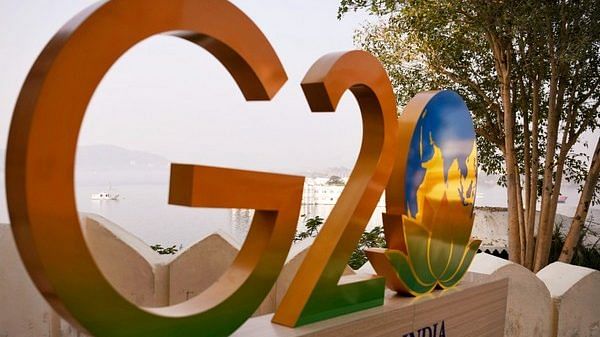The G20 was conceived in 1999 in the wake of the Asian financial crisis as a platform for finance ministers and central bank governors to deliberate on issues pertaining to global finance and economy. In 2008, it was elevated to include the heads of State against the backdrop of global recession. Today, representing more than 80 per cent of the world’s GDP, 75 per cent of global trade, and 60 per cent of the global population amid a crisis of global multilateralism, G20 has emerged as a premier forum for deliberation on global issues.
Since India’s assumption of the G20 presidency on 1 December 2022 in Indonesia, the Narendra Modi government, through different initiatives, is making an intense effort to showcase this occasion as the nation’s claim to global leadership. A visible dimension of this exercise is reflected in its participatory nature. The push for participatory diplomacy was evident in the speech delivered by Prime Minister Modi while inaugurating the 17th Pravasi Bharatiya Divas Convention in Indore on 9 January. He noted that India has “to make the G20 not just a diplomatic event but a historical event of the people’s participation.” A similar sentiment was echoed by the Ministry of External Affairs (MEA) wherein it reiterated New Delhi’s objective of making the G20 “truly a people’s G20”.
Hitting the ground well
The Modi government is envisaging jan bhagidari (people’s participation) in the G20 through various civic engagements. As per the MEA, India is slated to host more than 200 meetings, ranging across 50 cities and 32 working streams. In fact, on the very first day of its presidency, India hit the ground with a special University Connect programme: A virtual event that brought students from 75 universities across the country to interact with Minister of External Affairs S. Jaishankar and principal secretary to the prime minister P.K. Mishra. This initiative should be seen in the context of the government’s drive to link the youth to India’s global leadership aspiration through the G20 presidency.
Another significant aspect of this participatory diplomacy is the prioritisation of provinces/regions and showcasing of cultures that weren’t given due attention by the Indian State earlier. Nagaland’s Hornbill Festival was one of the main cultural events chosen by the government to be showcased during the launch of India’s new role in G20. The effort to broaden the initiative is being steered right from the top with PM Modi also deploying citizen engagement platforms such as Mann Ki Baat to seek civic legitimacy for India’s leadership aspirations. Further, everyday public spaces like railway stations and airports, too, are being plastered with banners highlighting the same.
The government has launched a selfie campaign in which citizens are encouraged to take selfies against the G20-themed illuminated monuments — the list of 100 monuments shortlisted for this initiative also features UNESCO heritage sites. While to some, these initiatives might appear frivolous at first, they go a long way in connecting the masses with the State’s diplomatic vision. This is also evident from how the G20 website has been designed; it has a dedicated portal for people to make suggestions on a range of themes.
Also read: G20 fault lines making it hard to walk its talk. India’s presidency a chance…
Look before 2022
The emphasis on participatory diplomacy is not limited to nor has just begun with the G20 presidency. Some signs of it were evident in a range of policy initiatives. Internationally, diaspora rallies have become a common feature of PM Modi’s overseas visits — an attempt to project India globally through its soft power and link overseas Indians with the country’s geopolitical aspirations. A similar trend is observed at the domestic level where there has been a concerted effort to take diplomacy away from the confines of Delhi. Varanasi in Uttar Pradesh, PM Modi’s constituency, is being developed as a centre for cultural diplomacy and is slated to host a four-day conference of G20 delegates in August. Ahmedabad hosted Chinese President Xi Jinping and former British PM Boris Johnson for high-level bilateral meetings with PM Modi in 2022.
Down South, Chennai and Mamallapuram in Tamil Nadu were venues in 2019 for high-level India-China bilateral meetings featuring respective heads of State. The same year, Guwahati was all set to host PM Modi and former Japanese Prime Minister Shinzo Abe for a bilateral meeting, but it was postponed due to protests over the Citizenship (Amendment) Act 2019. All this indicates not only the expanding geographical footprints of Indian diplomacy at the domestic level but also a much-needed policy corrective linking different parts of India with the nation’s geopolitical vision.
Critics can certainly say that New Delhi’s participatory zeal surrounding the G20 is seemingly overdone, as it is a routine affair, with the presidency itself being a rotational undertaking. Some may also look at it as the Bharatiya Janata Party (BJP) trying to shape the agenda of the 2024 Lok Sabha election. But the ongoing diplomatic euphoria can also be interpreted as a status-seeking endeavour to project the image of India as a global power seeking symbolic parity with major powers. Notwithstanding how this exercise is viewed, by engaging the masses and provinces, the Modi government is trying to make the performative dimension of diplomacy more democratic and dispersed — a phenomenon that deserves greater reflection by the observers and commentators of Indian foreign policy.
Harsh V Pant is Vice President for Studies and Foreign Policy at Observer Research Foundation, New Delhi and Professor at King’s College London. Paras Ratna is a doctoral candidate at the National University of Singapore, Singapore. Views are personal.
(Edited by Humra Laeeq)






